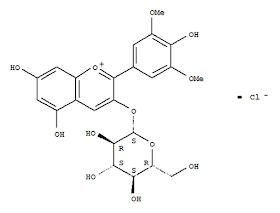As discussed previously, anthocyanins exist in grapes as glycosides (a bonding of the flavonoid component -- called an anthcyanidin -- with a sugar), a situation which increases both the chemical stability and solubility of the anthocyanidin.
The figure at the top shows the anthocyanidins in native form while the bottom shows a glucosylated Malvidin, Malvidin-3-glucoside.
The anthocyanin can be further complexed through the bonding of the sugar with either acetic, coumaric, or caffeic acid (Jackson).
 |
| Malvidin-3O-coumaroylglucoside |
In wine, spectral color is a function of anthocyanin concentration, the concentration of co-factors which bind with anthocyanin to cause co-pigmentation, and the number and quality of polymeric pigments (Enology Note #120).
In young red wines, anthocyanins occur predominantly as a dynamic equilibrium between one molecular state bonded to sulfur dioxide and four free-form states. Most of these forms are colorless within the range of of wine pH. The exception is a small portion that exists in the flavylium state (2-phenylchromenylium ion), that portion being dependent on pH and free-sulfur dioxide content. According to Jackson, low pH increases the concentration of the flavylium (thus increasing redness) while increases in pH will decrease the color density as the proportion of anthocyanin in the flavylium declines.
When sulfites bind to anthocyanins, the anthocyanins go from a colored to a colorless form (Practical Winery). Because of its effectiveness as an anthocyanin bleacher, sulfur dioxide is the most significant factor affecting the color density of young red wines (Jackson).
The free form of anthocyanin is rendered stable by a number of short- and long-term factors. The short-term factor that is most impactful is co-pigmentation, a process whereby anthocyanin complexes are held together by hydrophobic interaction with non-anthocyanin compounds (anthocyanin-anthocyanin aggregates combined similarly are referred to as self-associations). According to Jackson, the stacking of molecules in these complexes "physically limits water access to (and hydration of) red flavylium and bluish quinoidal base states to colorless carbinol forms." In the case of these co-pigmentation complexes "covalent bonds form between acyl groups of anthocyanin and co-pigments."
The principal compounds which act as co-pigments are epicatechin, procyanidins, cinnamic acids, and hydroxycinnamoyl esters but a wide array of compounds may be involved in this role (Jackson).
Co-pigmentation has the following effects on young red wines (Jackson; Boulton):
- It significantly increases color density and may affect color tint
- It accounts for over half of the observed color of young red wines
- It is important to the purplish coloration of young wines
- Color enhancement has been found to be between two and ten times that expected from the pigment alone
- It also adds temporary stability towards oxidation and SO₂ bleaching.
In the Northern Rhone, Syrah has normally been blended with a small amount of Viognier and the resulting wine is rich in color. Phillips notes the following Boulton comment: "The possibility exists in which red grapes that are deficient in certain cofactors might benefit from being fermented in the presence of others that might have an excess of them, especially if they are cofactors, such as flavones, with limited solubility."
Anthocyanins in polymeric relationships will be discussed in a subsequent post.
Bibliography
Boulton, The Copigmentation of Anthocyanins and its role in the color of Red Wines: A Critical Review, AJEV 52(2), 2001.
Curtis Phillips, Recent Research: Comments on a Critical Review, Wine Business Monthly, July 2003.
Robert S. Jackson, Wine Science.
Enology Note #120, Virginia Tech.
©Wine -- Mise en abyme



No comments:
Post a Comment